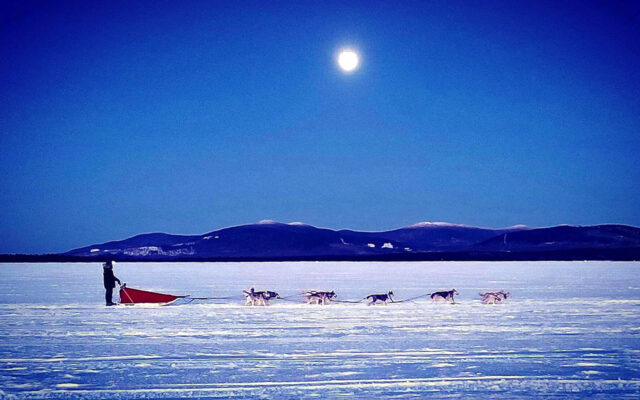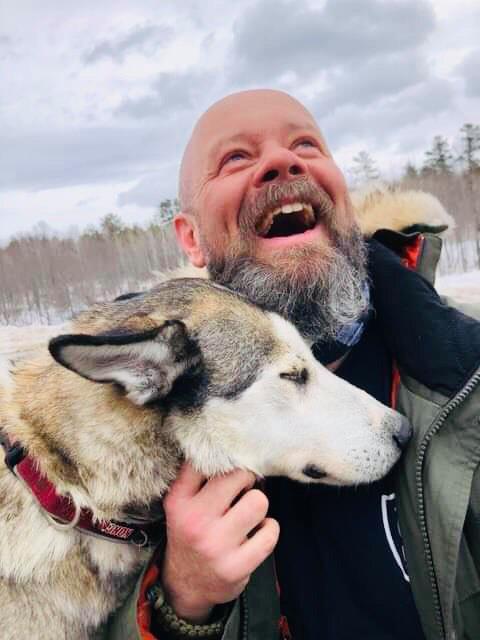
Musher and team finish 280-mile expedition in honor of heroic sled dog Togo
By Jessica Potila, St. John Valley Times Staff
FORT KENT — A St. John Valley musher and his team of eight — including a blind dog — not only achieved a 261-mile trek to honor the famous sled dog Togo, they exceeded it by 20 miles.
Saint David musher Jonathan Nathaniel Hayes, 45, and his team of Seppala Siberian sled dogs embarked on the northern Maine woods adventure to draw attention to Togo and to raise funds for a statue in the heroic sled dog’s image.
Togo led his master, Leonhard Seppala, and the rest of the Seppala dogsled team 261 miles through harsh weather to transport lifesaving antitoxin to the people of Nome, Alaska, during a 1925 diphtheria epidemic.

MOOSEHEAD CROSSING — Jonathan Nathaniel Hayes and his team of Seppala sled dogs cross Moosehead Lake during a week-long expedition to honor the famed sled dog Togo.
The Hayes team, descendants of those famous dogs, more than completed their own mission as well. They covered 280 miles from Fort Kent to Greenville in early March by way of Allagash, Round Pond, Umsaskis Lake, Chamberlain Lake, Chesuncook Lake and Moosehead Lake.
The journey took seven days and six nights to complete.
“If they failed it would not have been their fault but mine, that was my concern,” Hayes said. “I wanted to showcase the abilities of this heritage breed and do nothing that would detract from them.”
Hayes had planned alternate nights of camping out and staying at hunting camps along the route, but as word of the expedition spread, more camp hosts offered assistance — not unlike Seppala and Togo mushing from roadhouse to roadhouse almost 100 years ago. He only camped under the stars one night, on the ledges of Umsaskis.
The host camps provided welcome relief from what Hayes described as mountainous terrain the first three days of the expedition.
“I counted myself as the ninth dog on every hill and flat to assist during these days,” Hayes said. “I encouraged myself with the thought that I had three lake travel days ahead, but a total of 15 inches of fresh snow, 35 degree temps and massive overflow made my days of lake travel far more taxing on the dogs and myself than the mountains had been.”

TRAVEL BREAK — Musher Jonathan Nathaniel Hayes and his Seppala sled dog Sawyer.
“We were dealing with open water and slush that often came above my knees, breaking trail, snowdrifts and dead reckoning, using constellations one night and the compass in a white-out, to keep us in the right direction,” Hayes said.
The Hayes team included a blind dog, Sawyer, who especially found these weather conditions difficult to traverse. Hayes said Sawyer lost confidence when the team was knee-deep in slush and snow, but was good on the hard and solid trails.
Sawyer spent half of the last three days riding in the sled basket.
“This reduced the team’s power and added to the weight of the sled, but we all started this together, and we finished it together,” Hayes said. “Once the sun set and the temps dropped, the trail would get hard, then I’d bring him back out and the team would get a much needed boost.”
Hayes said there were also positive aspects of the journey.
“In our daily lives we often live with anxiety about the future, or regret over the past,” Hayes said. “Out on the trail you must be completely present — monitoring each dog’s gait, maneuvering the sled, caring for the team and for yourself. All those thoughts of the future and the past vanish.”
The Hayes expedition was part of a coordinated effort between Poland Spring Seppala Kennels and Poland Spring Preservation Society to raise funds for a statue of Togo to be erected at the Maine state building in Poland Spring.
Hayes is owner of Poland Spring Seppala Kennels in honor of Togo and Seppala, who had founded a kennel in Poland Spring where Togo retired after the historic Nome run.
So far, the initiative has raised $13,000 of the $25,000 needed for the project.
In the face of his team’s achievement, Hayes said he is humbled by those who inspired the mission.
“Seppala, Togo and the team were true heroes,” Hayes said. “They traveled 261 miles in obscenely cold temperatures — estimated between minus 50 and minus 80 — and crossed the treacherous frozen bay ice of Norton Sound twice to save the children of Nome.”
Hayes reported a positive parallel to the Togo serum run.
“After the expedition, Sawyer retired to Poland Spring Resort, to live with the owner, just as Togo did nearly 100 years ago,” Hayes said. “Seeing that narrative come full circle was poetic in its beauty. He now sleeps nightly by the same fireside Togo did.”